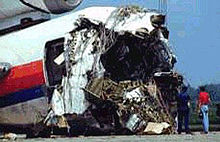United 232: a story of extremes
Forbes: Hungary’s Crocodile Dundee Recovery
15 January, 2014Forbes: After the Fragile Five, the Exposed Eight
17 January, 2014Discovery Channel Magazine, January 2014
The story of the United 232 air crash fits between two extremes. It is at once one of the greatest achievements in the history of aviation, and a desperate tragedy that cost 112 people their lives.
On July 19, 1989, a United Airlines DC-10 took off from Denver for Chicago O’Hare with 296 people on board. You don’t see DC-10s any more, nor their configuration, but in their time they were one of the leading wide-bodied aircraft in the skies, driven by three engines, one on each wing and a third mounted in the tail. An hour or so after takeoff, that tail engine exploded; worse – far worse – the shrapnel from the failed engine severed all three hydraulic systems for the plane, a combination of circumstances that had been believed to be impossible. No rudder. No flaps. No control, in short, of the systems that are supposed to help a plane turn left or right, or go up or down, or to be in any condition or trim to fly at all, let alone land.
At that point, it’s over. The possibility of all three systems failing was so remote it had never been trained for. It was not survivable, so why bother? There is no way to land a jet aircraft with no hydraulic controls. But through a combination of extraordinary ability and a considerable amount of luck, the crew brought the jet down in Sioux City, Iowa, and though it crashed, almost two thirds of those on board survived when everything in aviation said that they should have died.
To read more, contact me or Discovery Channel Magazine
